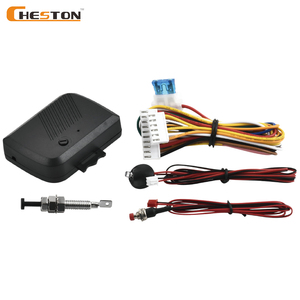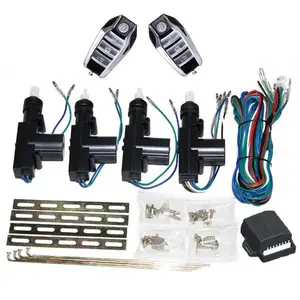(863 products available)










































































































































































































































Some common types of automatic car lock and unlock are as follows.
Keyless Entry System
The keyless entry system allows drivers to lock and unlock their cars without physically using a key, such as pressing buttons on a remote key fob. This system offers convenience and security features, such as panic buttons that activate audible alerts and vehicle identification that deters theft. Keyless entry systems, available as standard or optional equipment on many cars, include additional features like keyless ignition systems that allow engine starting without key insertion and proximity key systems that enable lock and unlock actions through smart keys within a specific range.
Smart Key System
Smart Key System technology enhances vehicle security and convenience by eliminating the need for traditional metal keys. With a smart key fob, drivers can perform keyless entry and ignition tasks, such as locking, unlocking, and starting the engine, while the fob remains in their pocket or purse. Moreover, this system allows customizable access to specific areas within the car and enables passive entry and ignition, automatically locking and unlocking the car and starting the engine with the fob's presence. The Smart Key System integrates advanced security measures to prevent unauthorized access, such as rolling codes and encrypted signals, making it a popular choice for luxury and high-end vehicles.
Remote Start System
The remote start system offers drivers the convenience of starting their vehicles remotely, allowing preconditioning of the interior climate and facilitating entry. This system, often integrated into keyless entry systems or available as aftermarket kits, enhances driving comfort and safety by enabling remote engine start with buttons on key fobs or smartphone apps. Additionally, the remote start system includes safety features that prevent unauthorized use and ensure safe engine operation under specific conditions.
Central Locking System
The central locking system is a widely used automatic car lock and unlock feature that controls all doors simultaneously, enhancing security and convenience. Typically activated by buttons on key fobs, dashboards, or door panels, the central locking system allows quick locking or unlocking of all doors, saving effort and time. Central locking systems also include additional security features, such as deadbolts and alarm integration, to prevent unauthorized access and enhance overall vehicle security. Many modern vehicles come equipped with central locking systems as standard features, while aftermarket kits are also available for added convenience and security.
Child Safety Locks
Child safety locks, located on the rear doors and manually activated or deactivated, enhance children's safety by preventing door opening from inside while driving. By restricting door access, child safety locks automatically lock and unlock the vehicle, reducing the risk of accidental door opening and ensuring a secure environment for children. These locks provide parents with peace of mind, knowing that their children are safe and secure within the vehicle, and are an essential safety feature in many modern cars.
Various features and components make up the automatic car lock and unlock system to ensure security and convenience for car owners. Here are some of the key specifications:
Keyless Entry Remote
The keyless entry remote is a handheld device that allows car owners to lock and unlock their cars from a distance. It has a lock button, an unlock button, and sometimes a panic button. The keyless entry remote also incorporates an immobilizer chip that communicates with the car's ignition system to prevent the car from starting when the key is not present. The keyless entry remote communicates with the car through a low-frequency signal, typically between 300 and 400 MHz. This frequency allows for short-range communication with the car's locking system. Pressing the lock or unlock button sends a signal to the car's body control module, instructing it to lock or unlock the doors. The body control module acts as a central hub, receiving signals from the keyless entry remote and executing the corresponding action. It also communicates with other car systems, such as the alarm system or central locking system.
Central Locking System
The central locking system controls all the door locks, allowing for simultaneous locking and unlocking. It consists of door lock actuators, linkage rods, and a control module. The door lock actuators are usually electric motors or solenoids that physically lock or unlock the doors by moving the locking mechanism (e.g., sliding a pin or rotating a lever). Linkage rods connect the door lock actuators to the door locking mechanism, translating the actuator's movement. The control module coordinates the central locking system's actions, receiving signals from the keyless entry remote or other car systems (e.g., alarm system or ignition switch).
Body Control Module
The body control module acts as the brain of the automatic locking and unlocking system. It communicates with different car systems (e.g., keyless entry remote, central locking system, alarm system) and coordinates their actions. The body control module also processes input signals from various sources, such as door switches, ignition switches, or keyless entry remote buttons. Based on these inputs, it executes corresponding actions, such as locking or unlocking the doors or activating the alarm system. It also controls other body-related functions, such as interior lighting, power windows, or remote trunk release.
Proximity Sensors
Proximity sensors are essential for advanced automatic locking and unlocking systems, especially in luxury or high-end cars. These sensors detect the presence of the key fob near the car and enable automatic locking and unlocking based on proximity. When the key fob is within a few feet of the car, the proximity sensors send a signal to the body control module, instructing it to unlock the doors automatically. This feature provides added convenience, allowing car owners to enter or exit the vehicle without pressing any buttons.
Security Features
The automatic locking and unlocking system incorporates various security features to protect against unauthorized access and potential theft. One such feature is the rolling code encryption. It ensures secure communication between the key fob and the car's locking system by generating a new code with every use. This feature prevents signal theft and unauthorized access to the car. Another security feature is the immobilizer system. It works with the keyless entry remote to prevent the car from starting without the key fob's presence. The immobilizer system communicates with the car's ignition system, validating the key fob's presence before allowing the car to start.
Maintaining the automatic locking and unlocking system is essential to ensure its proper functionality and security. Here are some general maintenance tips:
Battery Maintenance
Regularly check the key fob's battery and replace it when needed. Low battery power can affect its communication range and performance. Clean the key fob's exterior, especially around the buttons, to remove dirt, debris, or moisture that may affect its functionality.
Keep Drains and Locks Lubricated
Regularly lubricate the door locks and central locking system components (e.g., actuators, linkage rods) with appropriate lubricants (e.g., silicone spray, graphite powder) to ensure smooth operation and prevent wear and tear.
Inspect Wiring and Connections
Regularly inspect the wiring and connections of the keyless entry system, central locking system, and body control module for any damage, corrosion, or loose connections. Replace or repair them as needed to prevent communication or locking/unlocking issues.
Alarm System Maintenance
If the automatic locking and unlocking system is integrated with an alarm system, ensure its proper functionality. Check the alarm system's battery, siren, and sensors regularly and replace or repair them as needed.
By following these maintenance tips, car owners can ensure the proper functionality and security of the automatic locking and unlocking system, providing peace of mind and convenience.
There are many factors to consider when choosing an automatic car lock and unlock system. Here are some of them:
Security level
Consider the security level of the automatic car lock and unlock system. High-security systems have encryption codes that are hard for thieves to hack into. They also have rolling codes that change with every use, making it even harder for thieves to intercept the signal.
Car model and compatibility
Different car models have different keyless entry systems. Ensure the system chosen is compatible with the car's make and model. Check for features like key fob size, frequency, and programming methods that match the car's requirements.
Ease of use
Choose an automatic car lock and unlock system that is easy and convenient. Look for systems with key fobs that have buttons for locking and unlocking. Some systems may also have proximity sensors that allow entry into the car by just having the key fob nearby.
Installation and maintenance
Consider the installation process and ongoing maintenance requirements. Some systems are DIY-friendly, while others require professional installation. Additionally, check the maintenance requirements, such as battery replacements or periodic reprogramming.
Price and warranty
Set a budget for the automatic car lock and unlock system. Prices vary depending on features and security levels. Consider systems that offer good value without compromising security. Additionally, look for warranties or guarantees to protect against defects or failures.
Replacing an automatic lock and unlock system can be complicated. It is advisable to seek a professional car locksmith or mechanic to ensure the system works properly. However, it is possible to replace the system as a DIY project. Here are some steps to follow:
With these steps, replacing the automatic car lock and unlock feature is easy. Once installed, the feature offers convenience and security for the vehicle.
Q1: Are there any ways to prevent automatic car locks from malfunctioning?
A1: Yes, some steps can be taken to reduce the chances of automatic car lock malfunctions. Keeping the key fob away from moisture and extreme heat is one of them. Also, avoid dropping or physically damaging the key fob. Regularly replacing the battery before it dies can also help prevent lock malfunctions. Users should also keep the door and trunk locks clean and lubricated to reduce the chances of lock sticking.
Q2: What should users do when their key fob is malfunctioning and preventing them from locking or unlocking the car?
A2: When facing this problem, users should first try replacing the key fob battery. If the problem persists, they should consider reprogramming the key fob or contacting the dealer for assistance. In the meantime, many cars have mechanical lock cylinders. Users can use the physical key to manually unlock the doors and access the vehicle.
Q3: What causes the automatic car lock and unlock system to malfunction?
A3: Various factors can cause automatic car lock malfunctions. One of the most common reasons is a dead key fob battery. Other causes include physical damage to the key fob, interference from other electronic devices, or issues with the car's central locking system. Wiring problems, moisture damage, and extreme temperatures can also lead to lock malfunctions.
Q4: Can users disable the automatic locking feature if it locks the car too quickly?
A4: Yes, some cars allow users to adjust the automatic locking settings or disable the feature if it locks the vehicle too quickly. The procedure varies depending on the car model. Users can refer to the owner's manual for instructions or contact the dealer for assistance.
Q5: Do all cars have an automatic lock and unlock feature?
A5: Not all vehicles have the automatic lock and unlock feature. While it's standard in many modern cars, especially higher-end ones, some basic models may lack this feature. Users can install aftermarket systems to enable this functionality in cars that do not have it.